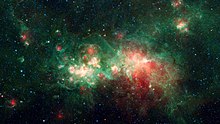
Back Stervorming Afrikaans تكون النجوم Arabic Formación estelar AST Звездообразуване Bulgarian তারা গঠন Bengali/Bangla Formiranje zvijezda BS Formació estel·lar Catalan Vznik hvězdy Czech Çăлтăр йĕркеленĕвĕ CV Sternentstehung German

Star formation is the process by which dense regions within molecular clouds in interstellar space—sometimes referred to as "stellar nurseries" or "star-forming regions"—collapse and form stars.[1] As a branch of astronomy, star formation includes the study of the interstellar medium (ISM) and giant molecular clouds (GMC) as precursors to the star formation process, and the study of protostars and young stellar objects as its immediate products. It is closely related to planet formation, another branch of astronomy. Star formation theory, as well as accounting for the formation of a single star, must also account for the statistics of binary stars and the initial mass function. Most stars do not form in isolation but as part of a group of stars referred as star clusters or stellar associations.[2]
- ^ Stahler, S. W. & Palla, F. (2004). The Formation of Stars. Weinheim: Wiley-VCH. ISBN 3-527-40559-3.
- ^ Lada, Charles J.; Lada, Elizabeth A. (2003-09-01). "Embedded Clusters in Molecular Clouds". Annual Review of Astronomy and Astrophysics. 41 (1): 57–115. arXiv:astro-ph/0301540. Bibcode:2003ARA&A..41...57L. doi:10.1146/annurev.astro.41.011802.094844. ISSN 0066-4146. S2CID 16752089.